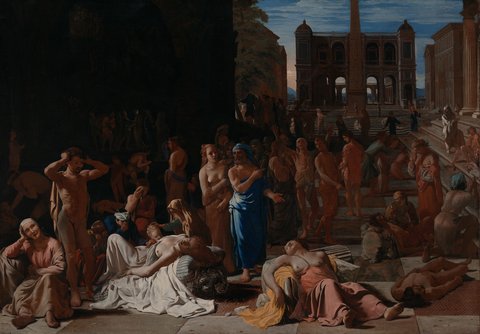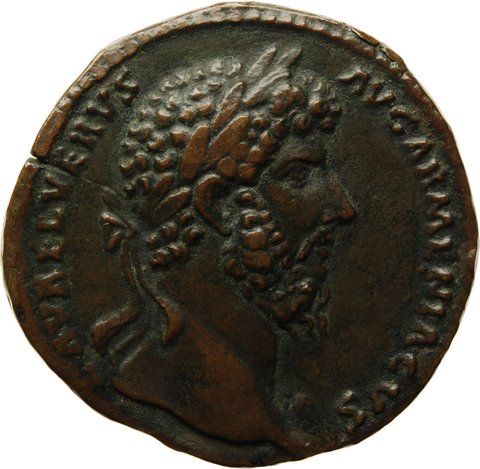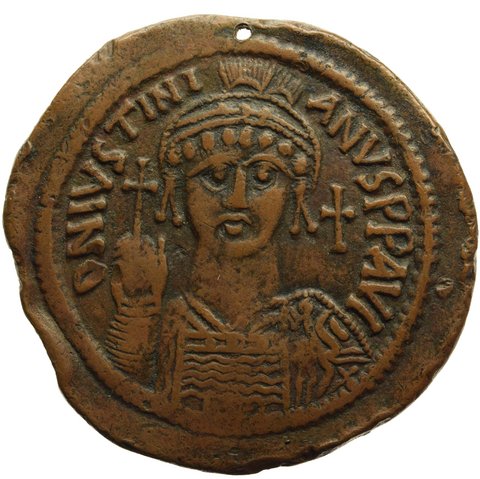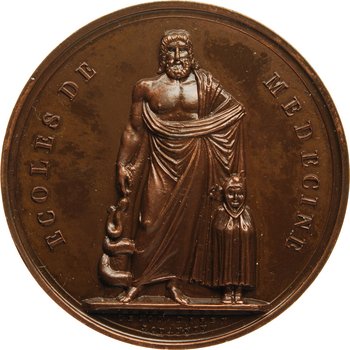One of the earliest recorded historical epidemics is the “Plague of Athens”, which hit the city-state between 430 and 426 BC. The only written record is the “History of the Peloponnesian War” by Thucydides, who himself contracted the disease, but survived.

Michiel Sweerts: Die Attische Seuche (um 1653) © Public Domain
The malady broke out in the port of Piraeus, probably introduced via the Athenian fleet. Due to the war, Athens was overcrowded, which was instrumental in the disease’s spread. Thucydides’ description is only superficially medical, however; in reality it is mainly a literary construct. The decline in values it portrays is contrasted with the Funeral Oration delivered by Pericles, focusing on Athens’ virtues. The speech advances as rapidly as the outbreak of the “Plague of Athens”, emphasising the great momentum of the war that brought the disease with it, and the horror of the epidemic that damaged the Athenians’ moral compass within such a short time. Another symbol of Athens’ fall from its pinnacle was the death of Pericles, who was held responsible for the epidemic among the people.
Outbreaks of disease were also not uncommon in Ancient Rome. Malaria, in particular, was a recurring phenomenon in the summer, regularly sending the elite fleeing to the countryside. However, the “Antonine Plague”, which broke out in AD 165, imported by soldiers returning from the Parthian War, was something entirely different: an unknown disease accompanied by a rash and fever.
Both the horror wrought by the disease and the death toll were so great that historians such as Ammianus later ascribed it to Apollo’s anger. While pillaging the city in search of treasures, soldiers under Lucius Verus – who himself may have died in the epidemic – were said to have broken a casket dedicated to the god, releasing the “plague” into the world at large.

Sesterz des Kaisers Lucius Verus, 163-164, Bronze, MK, Inv. Nr. ACC2055 © Staatliche Kunstsammlungen Dresden, Münzkabinett
The “Plague of Cyprian” (AD 250–270), which spread throughout the Mediterranean, was described by the historian Cyprian as involving attacks of fever. Excavations have shown that during the epidemic, the number of cremations rose rapidly in certain regions of Egypt as a precautionary measure to contain the disease. The death toll was terrible. At the height of the epidemic, an estimated 5,000 people died every day in Rome.
Two emperors, Hostilian (251) and Claudius Gothicus (270), were among those to die as a result of the disease. The epidemic is thought to have played a key role in the later fall of the Imperium Romanum due to its wide economic and social effects.

Nummus des Kaisers Justinian, 541-542, bronze, MK, Inv.-Nr. ADC16383 © Staatliche Kunstsammlungen Dresden, Münzkabinett
It is highly likely that the “Plague of Justinian” that hit the Roman Empire in AD 541–544 was an epidemic of the bubonic plague. Emperor Justininian himself contracted it, but survived. The apparently short duration of the outbreak hides the fact that it continued to return in waves until the year 770. One of the most important sources of information is a report by Gregory of Tours describing the effects of the “plague” in the Rhône valley. The dimensions of its impact on the Eastern Roman Empire are disputed, as is the number of victims. While older works of academic literature were based on the premise that up to 50 per cent of the population died, modern estimates are far more conservative. This is supported by the fact that there is no widespread rise in the number of burial places, or mass graves from the time of the plague.
In the ancient world, many people believed in deities of healing, as epidemics themselves were said to be signs of the gods’ wrath. Two of the most important health deities were the god Apollo’s son Asclepius (known in Rome as Aesculapius), and the latter’s daughter Hygieia (in Rome: Salus). They were sometimes depicted on coins, especially in times of epidemics.
Also of interest:
What coins and medals say about epidemics
What we can learn from coins and medals goes far beyond discovering hidden hoards or studying the economic consequences of events. Such artefacts also tell us about societies’ beliefs, hopes and fears. Currently, an exhibition at the Münzkabinett (Numismatic Collection) is devoted to the connection between coins and epidemics. Curator Ilka Hagen explains here what one has to do with the other.

Last round at the "Weißes Ross"
A pub in the museum? There are many inviting, sociable places in Leipzig. In recent years, numerous old pubs have had to close, including the Weißes Roß ("White Horse") owned by Jens-Thomas Nagel. It was located near the Grassimuseum, today it is housed inside of it.

Ortsgespräche ("Local CONVERSATIONS"): Schenkung Sammlung Hoffmann IN DIALOGUE WITH SCHKEUDITZ
With the "Ortsgespräche" series, the Schenkung Sammlung Hoffmann also makes itself available for art locations in the so-called rural areas of Saxony, where the diversity and social topicality of contemporary art is sometimes put up for discussion with particular vehemence. In the second edition of the year this is done in cooperation with the art Kapella Schnkeuditz e. V.
